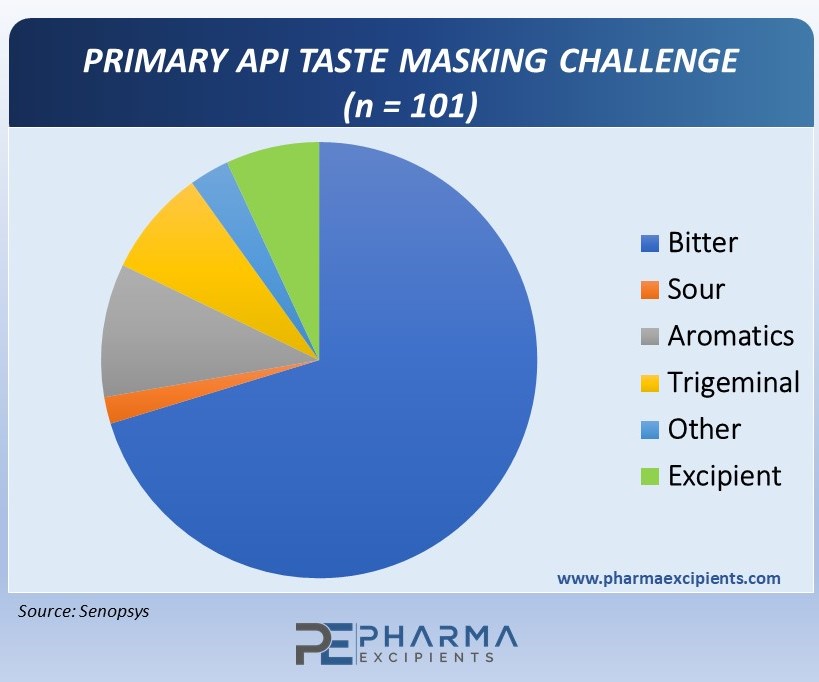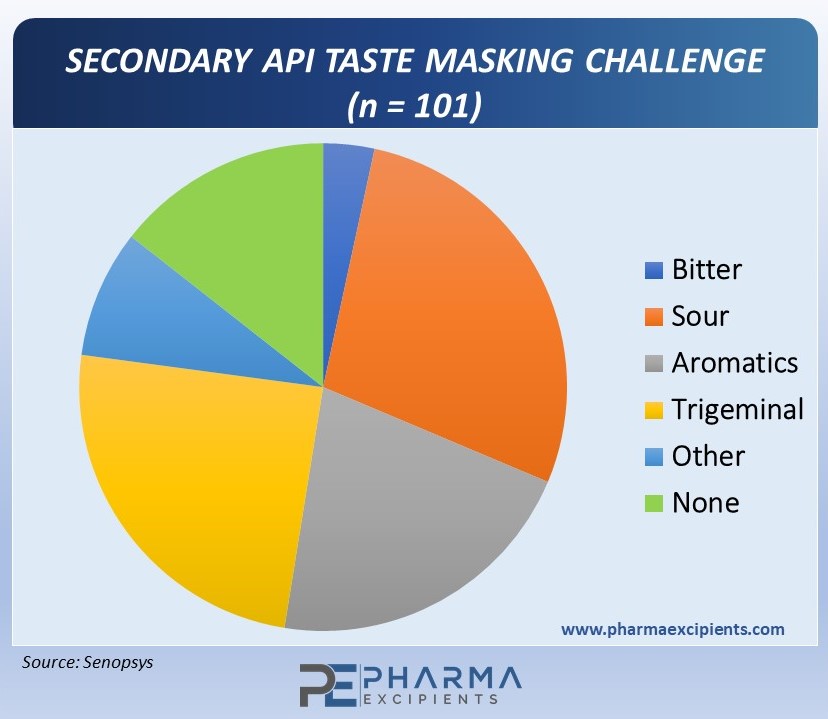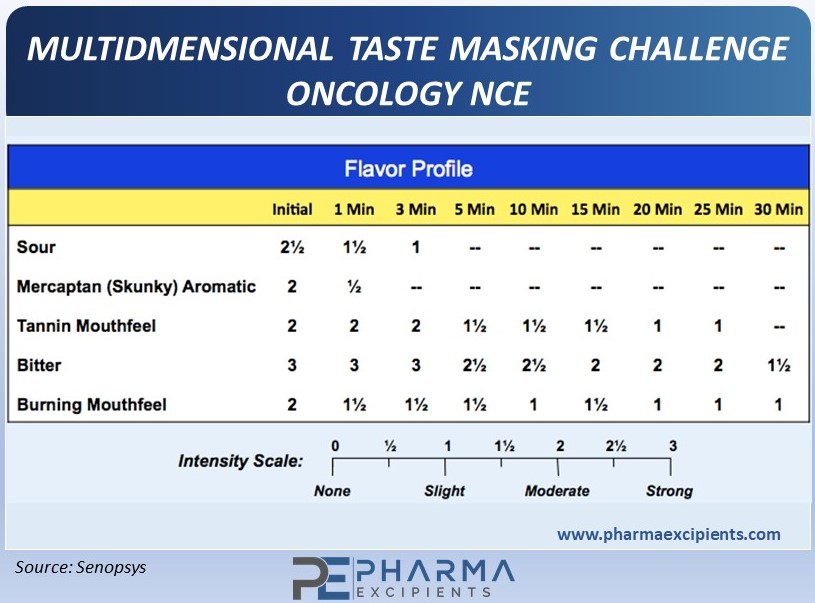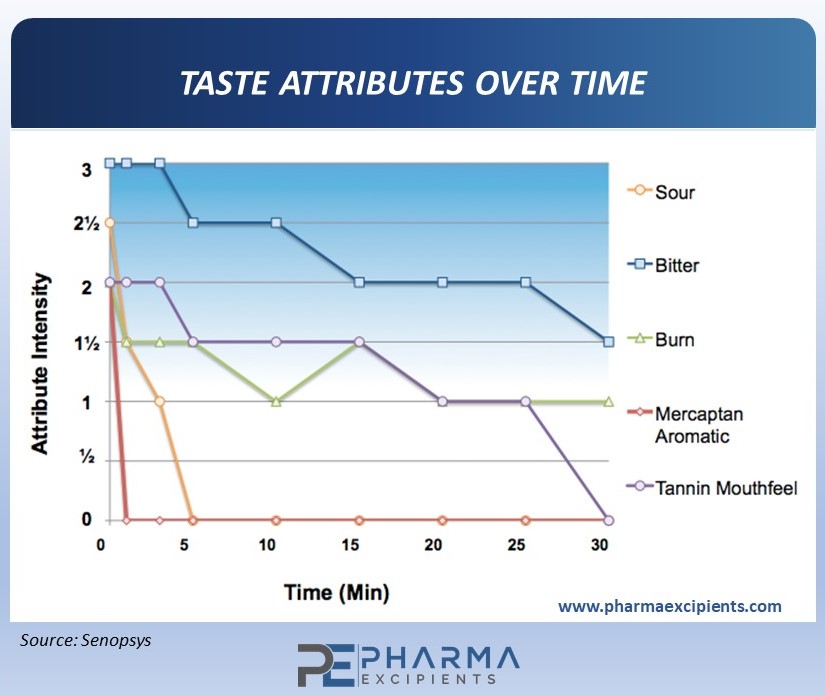API Taste Masking Challenges
It is widely recognized that many Active Pharmaceutical Ingredients (APIs) are bitter, some extremely so. But bitterness is not the only challenge in creating palatable, patient-accepted drug products. If not bitter, what are other common aversive sensory attributes? To answer this question, data was compiled retrospectively from one hundred taste assessment studies.
Primary Taste Masking Challenge
The sensory analysis results were tabulated from 101 taste assessment studies conducted by Senopsys. Approximately 90 percent of the studies measured the sensory attributes of new chemical entities (NCEs) and over-the-counter drugs were excluded. The actives evaluated represented a wide range of indications, potency, BCS classification, and intended dosage form.
Bitterness was the primary taste masking challenge for three quarters of the APIs as shown in the pie chart below. Of the other basic tastes, a few were sour (2%) or salty (combined into the “Other” category). None were found to be sweet.

Obnoxious odors (malodors) were the next most frequently encountered attribute and represented the primary sensory challenge for approximately 10% of APIs. Some of the descriptors of these malodors include “phenolic” (like Band-Aids), “sulfidy” (overcooked cruciferous vegetables), “oxidized oil” (like old paint), and “solventy” (e.g., acetone).
The primary challenge for 8% of the APIs was strong intensity trigeminal irritancy (e.g., burning).
Finally, 7% of APIs were fundamentally tasteless, but their challenge was driven by the negative sensory attributes of the excipient system, e.g., solubility enhancers.
Most APIs have multiple aversive attributes
There’s a general misconception that APIs can be characterized by a single aversive attribute but that’s not borne out by the data. The pie chart below shows the secondary aversive attributes. Unlike the heavily bitter-weighted primary challenge, these secondary challenges are evenly divided between sour basic taste, aromatics (malodor) and trigeminal irritancy. Of note, about 25% of the general population confuses bitter and sour basic tastes, which can inadvertently lead to a misdiagnosis of the taste masking challenge.

Why is it important to identify the aversive sensory attributes?
The first step to solving a palatability issue is to correctly diagnose the taste masking challenge. Taste, smell, and irritation represent different perception pathways and importantly, the approach for dealing with each is fundamentally different.
“Taste” refers to those sensations – sweet, sour salty and bitter – perceived through stimulation of the receptor cells located in the taste buds on the tongue and oral cavity. In a flavor system, taste issues are addressed via balancing their intensity with the application of other basic tastes to minimize the perception of each individually.
Negative aromas may be minimized through the judicious incorporation of commercial “flavors” which are mixtures of aroma chemicals that are perceived through the sense of smell (olfaction) – orange, strawberry, mint. These have no effect in reducing bitterness or the other so called basic tastes – sweet, sour and salty
Similarly, compounds such as capsaicin (found in red pepper), piperine (found in black pepper) and many APIs produce a burning sensation when the trigeminal nerve is activated (chemesthesis). The addition of tastants or odorants (flavors) has no effect on burning in the same way aspirin would not be administered to treat a bacterial infection.
How are the aversive sensory attributes identified?
Many approaches have been explored over the years to characterize and quantify the sensory attributes of APIs and drug products. These include in-vitro techniques and sensory analysis by trained subjects. According to FDA and EMA, while many of the in-vitro techniques may provide an indication of a palatability issue, sensory analysis using trained subjects remains the definitive method for identifying and quantifying the taste masking challenge APIs and drug products.
Descriptive sensory analysis is an analytical technique used to identify and quantify the basic taste, aroma, irritation, and texture of drug actives and formulations. Senopsys uses the Flavor Profile descriptive method, an internationally recognized, open-source (ASTM) method of sensory analysis.
To illustrate descriptive sensory analysis, the Flavor Profile results for a NCE indicated for oncology are shown below. Clinical studies of the drug were truncated due to strong positive results in adults and a pediatric dosage form was urgently required. The analysis was conducted to identify and quantify the aversive sensory attributes of the API as necessary to inform the development of a palatable, age-appropriate formulation.
 In Flavor Profile analysis, the panelists separate flavor into its components, measuring the individual attributes in the order they were perceived using an intensity scale that ranges from none (0) to strong (3) that is established using chemical reference standards.
In Flavor Profile analysis, the panelists separate flavor into its components, measuring the individual attributes in the order they were perceived using an intensity scale that ranges from none (0) to strong (3) that is established using chemical reference standards.
Palatable drug products are those in which the aversive sensory attributes are below the recognition (palatability) threshold, which corresponds to a 1 on the Flavor Profile scale. Accordingly, the oncology drug represents a multidimensional taste challenge, specifically sour and bitter basic tastes, mercaptan (skunky) aromatics, and burning and tannin mouthfeels.
Many foods and beverages have strong intensity attributes that are perceived immediately upon mastication but quickly diminish in the aftertaste. In contrast, the aversive attributes of many APIs can linger in the aftertaste for 10, 20, 30 minutes or even hours. From a taste masking perspective, ameliorating the lingering effects of long-lived bitterness is far more challenging than short acting compounds such as caffeine. As shown below for the oncology API, skunky aromatics faded quickly in the aftertaste, as did sourness. However, bitterness and mouthfeel is lingered for at least 30 minutes.

Running Diagnostics is Key.
Analytical sensory analysis using trained panelists ensures that the aversive attributes of the API (and excipients) are correctly identified and quantified. Conducting sensory analysis early in clinical development – ideally immediately following successful safety/pharmacokinetic studies – helps reduce technical risks associated with developing palatable, taste masked drug products.
Blog Post for pharmaexcipients.com – Prepared by Senopsys LLC by David Tisi — All Rights Reserved
David Tisi is the Technical Director of Senopsys LLC, a specialty services firm dedicated to the development of palatable drug products. He has 15 years of experience in taste assessment and taste masking of investigational and approved drugs for children and adults, leveraging his background in sensory science and food chemistry. He can be reached at [email protected]

